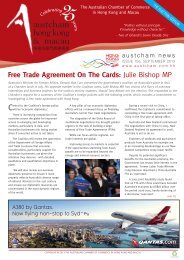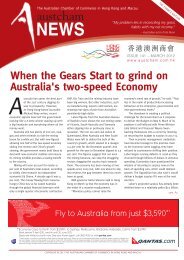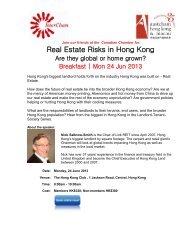Issue 145 - The Australian Chamber of Commerce in Hong Kong.
Issue 145 - The Australian Chamber of Commerce in Hong Kong.
Issue 145 - The Australian Chamber of Commerce in Hong Kong.
You also want an ePaper? Increase the reach of your titles
YUMPU automatically turns print PDFs into web optimized ePapers that Google loves.
10 | COMMITTEE COMMENT<br />
Your Bus<strong>in</strong>ess and the Carbon Pric<strong>in</strong>g Mechanism<br />
Bree Miechel, a member <strong>of</strong> AustCham’s Susta<strong>in</strong>able Development Committee,<br />
is a Manag<strong>in</strong>g Associate at Simmons & Simmons. Here she outl<strong>in</strong>es what your<br />
bus<strong>in</strong>ess should aware <strong>of</strong> under the new <strong>Australian</strong> Carbon Tax system.<br />
<strong>The</strong> contentious Carbon Pric<strong>in</strong>g<br />
Mechanism (“CPM”) came <strong>in</strong>to effect<br />
<strong>in</strong> Australia on 1 July. Over the next<br />
3 years, emissions units are to be<br />
issued by the Government (the “fixed price<br />
period”), and from 2015 onwards a ‘capand-trade’<br />
scheme is to be <strong>in</strong>troduced (the<br />
“flexible price period”).<br />
1. Will the CPM affect my bus<strong>in</strong>ess?<br />
Large emitters <strong>of</strong> greenhouse gases<br />
(referred to as “liable entities”) will<br />
need to obta<strong>in</strong> carbon permits <strong>in</strong><br />
exchange for every tonne <strong>of</strong> CO2<br />
equivalent produced. Whilst these<br />
are to be obta<strong>in</strong>ed by direct emitters,<br />
the impact <strong>of</strong> the carbon price will<br />
<strong>in</strong>evitably trickle down the supply cha<strong>in</strong><br />
and affect the prices <strong>of</strong> goods and<br />
services market-wide. <strong>The</strong> most obvious<br />
sectors that will be directly impacted<br />
are:<br />
• M<strong>in</strong><strong>in</strong>g<br />
• Manufactur<strong>in</strong>g<br />
• Natural gas suppliers<br />
• Industrial processes (cement,<br />
chemicals, metal process<strong>in</strong>g)<br />
• Waste disposal<br />
2. What are the different types <strong>of</strong><br />
emissions units under the CPM?<br />
Three types <strong>of</strong> carbon permits can<br />
be used at different times under the<br />
scheme: Carbon Units, <strong>Australian</strong><br />
Carbon Credit Units (“ACCUs”) and<br />
Eligible International Emissions Units<br />
(“EIEUs”).<br />
3. How can my bus<strong>in</strong>ess satisfy its liability<br />
dur<strong>in</strong>g the “fixed price period”?<br />
From 1 July 2012 to 1 July 2015, Carbon<br />
Units will be sold by the Clean Energy<br />
Regulator at a fixed-price. Trad<strong>in</strong>g will<br />
be m<strong>in</strong>imal as the units will expire on 1<br />
February <strong>of</strong> the follow<strong>in</strong>g year and can<br />
be resold to the Regulator.<br />
ACCUs are emission units generated by<br />
land-based sequestration and <strong>of</strong>fset<br />
projects and may be used to <strong>of</strong>fset up<br />
to 5% <strong>of</strong> a liable entity’s obligations<br />
dur<strong>in</strong>g the fixed price period.<br />
4. How can my bus<strong>in</strong>ess satisfy its liability<br />
dur<strong>in</strong>g the “flexible price period”?<br />
From 2015 onwards, a ‘cap-and-trade’<br />
scheme will operate. For the first 3<br />
years until 2018, to m<strong>in</strong>imise price<br />
volatility the price <strong>of</strong> carbon permits<br />
must fall between pre-set floor and<br />
ceil<strong>in</strong>g prices. After this, pric<strong>in</strong>g will<br />
be flexible and determ<strong>in</strong>ed by market<br />
forces. <strong>The</strong> cap will be set every 5<br />
years to reflect Australia’s commitment<br />
to greenhouse gas reduction targets<br />
and <strong>in</strong>ternational climate change<br />
obligations.<br />
Unlike the fixed price period,<br />
bus<strong>in</strong>esses will not be restricted to<br />
us<strong>in</strong>g Carbon Units and ACCUs to meet<br />
their compliance obligations. EIEUs may<br />
also be used to meet up to 50% <strong>of</strong> a<br />
bus<strong>in</strong>ess’ liability. EIEUs <strong>in</strong>clude units<br />
issued <strong>in</strong> accordance with the Kyoto<br />
Protocol such as Certified Emission<br />
Reductions generated by Clean<br />
Development Mechanism projects.<br />
5. What restrictions apply to trad<strong>in</strong>g<br />
emissions units?<br />
Carbon Units, ACCUs and EIEUs are<br />
considered f<strong>in</strong>ancial products under<br />
the Corporations Act 2001. Accord<strong>in</strong>gly,<br />
entities deal<strong>in</strong>g <strong>in</strong>, creat<strong>in</strong>g a market<br />
for or advis<strong>in</strong>g on such products may<br />
need to obta<strong>in</strong> an <strong>Australian</strong> F<strong>in</strong>ancial<br />
Services Licence (“AFSL”) or seek a<br />
variation to an exist<strong>in</strong>g AFSL from the<br />
<strong>Australian</strong> Securities and Investments<br />
Commission. Certa<strong>in</strong> limited exceptions<br />
apply <strong>in</strong>clud<strong>in</strong>g for (1) <strong>in</strong>dividual<br />
traders, (2) entities provid<strong>in</strong>g services<br />
to a related body with<strong>in</strong> a corporate<br />
structure (exclud<strong>in</strong>g jo<strong>in</strong>t ventures)<br />
for the purposes <strong>of</strong> f<strong>in</strong>ancial risk<br />
management, and (3) entities acquir<strong>in</strong>g<br />
emissions units for their own use<br />
(exclud<strong>in</strong>g OTC derivatives).<br />
6. Does the CPM create any opportunities<br />
for non-liable entities and foreign<br />
<strong>in</strong>vestors?<br />
Yes. <strong>The</strong> <strong>Australian</strong> Government has<br />
established the Clean Energy F<strong>in</strong>ance<br />
Corporation (“CEFC”) with AUD10 billion<br />
fund<strong>in</strong>g to assist with the development<br />
<strong>of</strong> renewable energy resources and<br />
clean energy projects. Provided that<br />
a bus<strong>in</strong>ess is primarily located <strong>in</strong><br />
Australia, it may apply for assistance<br />
through the CEFC. It is anticipated<br />
that the CEFC could unlock over AUD50<br />
billion <strong>in</strong> private capital.<br />
7. What should my bus<strong>in</strong>ess do to prepare<br />
for the CPM?<br />
Even if your bus<strong>in</strong>ess is not a liable<br />
entity, it is important to mitigate the<br />
potential impact <strong>of</strong> the CPM by mak<strong>in</strong>g<br />
appropriate management decisions.<br />
You may consider the follow<strong>in</strong>g:<br />
• Assess<strong>in</strong>g the<br />
potential impact <strong>of</strong> the CPM on<br />
current and future <strong>in</strong>vestments<br />
• Exam<strong>in</strong><strong>in</strong>g eligibility for Government<br />
grants and funds<br />
• Consider<strong>in</strong>g the impact <strong>of</strong> the carbon<br />
price when negotiat<strong>in</strong>g contracts<br />
• Prepar<strong>in</strong>g for <strong>in</strong>ternational trad<strong>in</strong>g<br />
opportunities <strong>in</strong> the future with the<br />
EU, New Zealand and other Asian<br />
markets<br />
Whether or not the scope <strong>of</strong> the CPM<br />
appropriately balances Australia’s<br />
environmental and economic<br />
considerations, the pric<strong>in</strong>g <strong>of</strong> carbon<br />
emissions is a step <strong>in</strong> the right<br />
direction. It is important for the<br />
susta<strong>in</strong>able development <strong>of</strong> the<br />
<strong>Australian</strong> economy and our stand<strong>in</strong>g<br />
as <strong>in</strong>ternational citizens.<br />
CORPORATENEWS<br />
NEWS<br />
Cundall w<strong>in</strong>s HK Green<br />
Build<strong>in</strong>g Grand Award<br />
<strong>Hong</strong> <strong>Kong</strong> Science Park Phase 3<br />
has won the <strong>Hong</strong> <strong>Kong</strong> Green<br />
Build<strong>in</strong>g 2012 Grand Award<br />
<strong>in</strong> the build<strong>in</strong>g under design<br />
category. <strong>The</strong> project is aim<strong>in</strong>g to<br />
achieve one <strong>of</strong> <strong>Hong</strong> <strong>Kong</strong>'s first LEED<br />
v2009 Plat<strong>in</strong>um rat<strong>in</strong>gs and a HK BEAM<br />
Plus Plat<strong>in</strong>um rat<strong>in</strong>g.<br />
<strong>The</strong> Green Build<strong>in</strong>g Awards aim to<br />
provide recognition to build<strong>in</strong>g-related<br />
projects with outstand<strong>in</strong>g performance<br />
and contributions <strong>in</strong> susta<strong>in</strong>ability and<br />
the built environment.<br />
Cundall provided susta<strong>in</strong>able design<br />
consultancy, support<strong>in</strong>g the design<br />
team, project manager and <strong>Hong</strong> <strong>Kong</strong><br />
Science Park <strong>in</strong> this award w<strong>in</strong>n<strong>in</strong>g<br />
design.<br />
Established s<strong>in</strong>ce 1976, Cundall has<br />
evolved from a UK-based company to a<br />
worldwide organisation with 22 <strong>of</strong>fices<br />
<strong>in</strong> 11 countries <strong>of</strong>fer<strong>in</strong>g susta<strong>in</strong>ability<br />
advice over the past 35 years. <strong>The</strong>ir<br />
major projects <strong>in</strong>clude: <strong>The</strong> Royal<br />
Children’s Hospital <strong>in</strong> Melbourne, South<br />
<strong>Australian</strong> Health Medical Research<br />
Institute and South Australia Water<br />
House.








